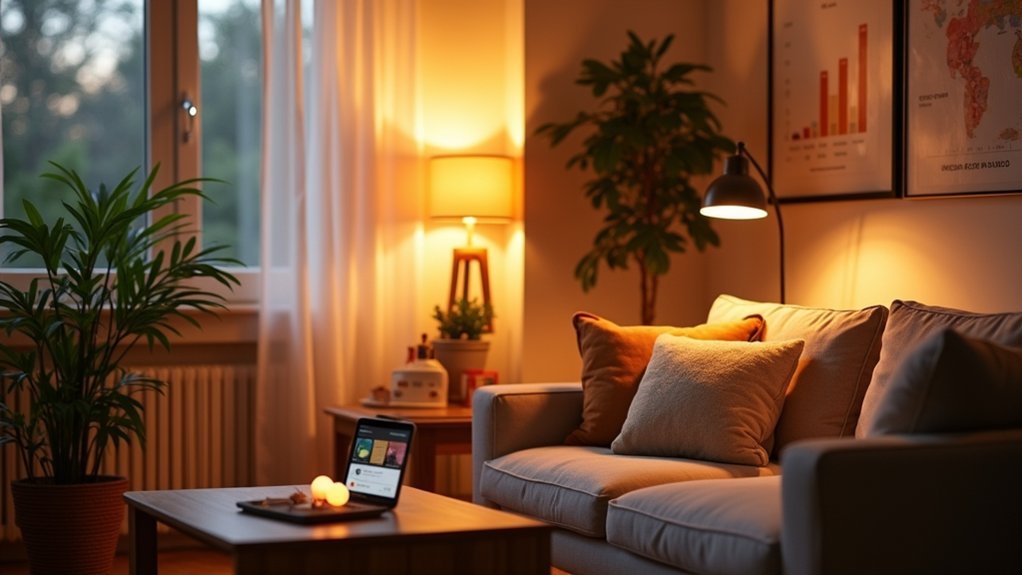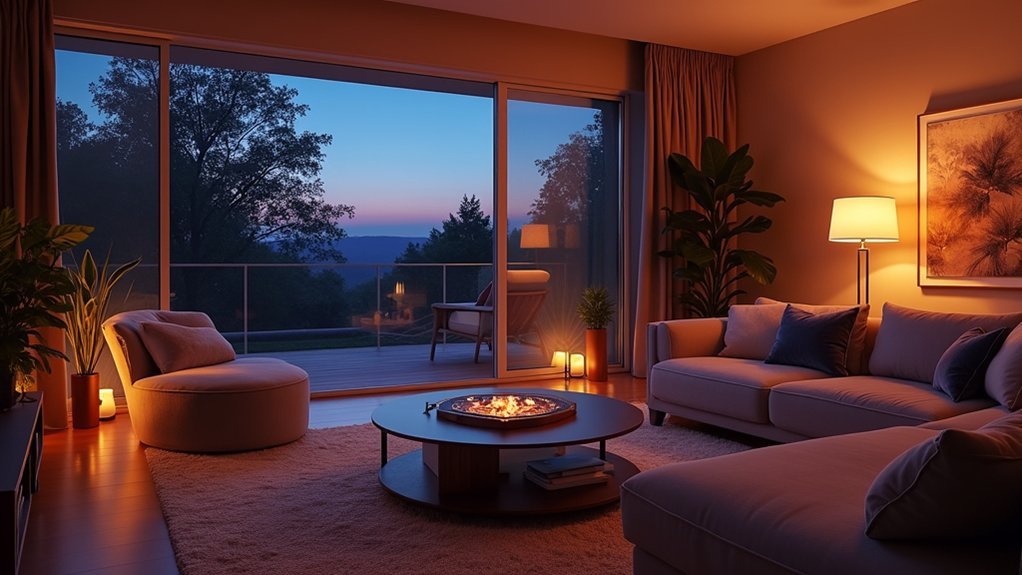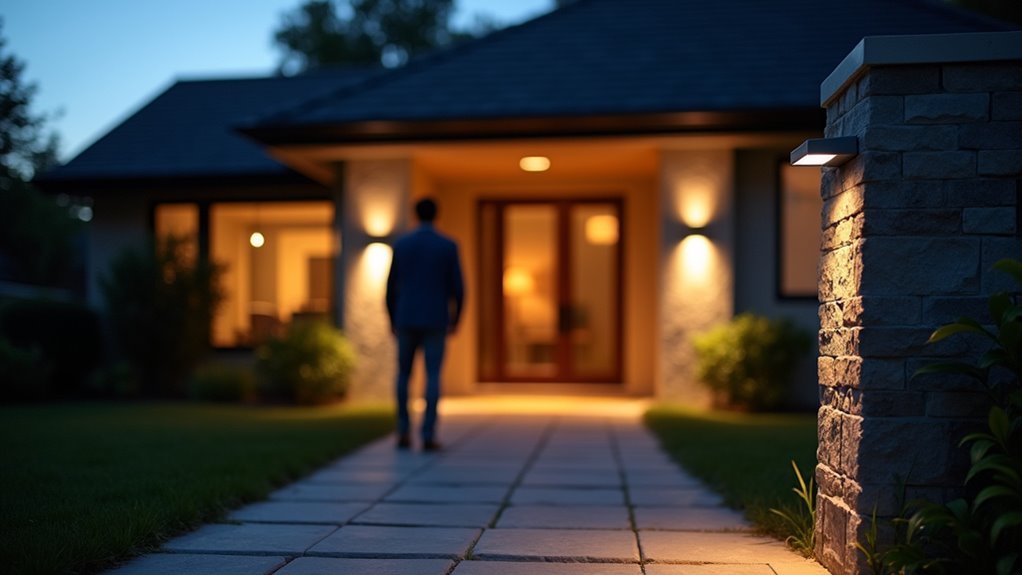Smart lighting transforms your home by cutting energy costs up to 70% compared to traditional bulbs, saving the average family $225 annually. You’ll enjoy the convenience of controlling lights from anywhere using your smartphone or voice commands. These systems improve your sleep quality with circadian-friendly settings, enhance home security through automated schedules, and deter intruders with occupancy simulation. Most options offer simple DIY installation, making this smart upgrade both accessible and practical for any homeowner.
Energy Savings That Pay You Back Every Month

Dollars saved add up quickly when you switch to smart lighting solutions for your home.
Making the switch to smart lighting isn’t just convenient—it’s a financial no-brainer that delivers immediate savings.
You’ll immediately slash power consumption by up to 70% compared to your old incandescent bulbs, while maintaining the same brightness. A 10W smart LED delivers the same 800-1000 lumens as a 60W traditional bulb.
With lighting accounting for about 15% of your household electricity use, the average family saves approximately $225 annually after switching.
Your monthly electric bills can drop by over 80% for lighting costs alone, contributing to overall utility bill reductions of 5-22% when combined with other smart home systems.
The real magic happens when smart lighting’s IoT capabilities optimize illumination based on your actual needs, further reducing energy waste. Motion sensors and photodetectors can reduce your energy consumption by an additional 20% to 40% by automatically adjusting brightness based on activity.
Control Your Home Lighting From Anywhere
While saving money is a compelling benefit, the convenience of smart lighting extends far beyond your wallet. With remote access capability, you can control your home’s illumination from anywhere using your smartphone or voice commands.
- Safety and security – Simulate occupancy by turning lights on and off while you’re away, deterring potential intruders. React immediately to suspicious activity by illuminating your property from anywhere.
- Ultimate flexibility – Adjust lighting when plans change, like turning on porch lights when you’re running late or creating the perfect ambiance for guests before you arrive home.
- Seamless integration – Connect your lighting with other smart home systems through voice assistants like Alexa or Google Assistant for hands-free control up to 40 meters indoors. Smart lighting systems utilize various communication technologies like Infrared, RF, Bluetooth, and Wi-Fi to ensure reliable operation across different environments.
Sleep Better With Circadian-Friendly Smart Bulbs

Your home lighting affects far more than visibility—it directly impacts your sleep quality and overall health.
Circadian-friendly smart bulbs mimic natural daylight patterns to regulate your body’s rhythms, enhancing sleep and improving mood.
These intelligent bulbs automatically adjust throughout the day—providing energizing bright light in the morning to boost alertness, and gradually dimming to warmer tones in the evening to avoid suppressing melatonin production.
Smart lighting optimizes your day, brightening mornings for energy and softening evenings to preserve natural sleep hormones.
This natural cycle helps you wind down properly and wake up refreshed.
Beyond sleep benefits, these lights can improve your cognitive performance, help adapt to shift work schedules, and even combat seasonal changes in daylight hours. Recent studies demonstrate that just one hour of daily exposure to circadian lighting can significantly improve sleep quality for various populations, including those with dysregulated sleep patterns.
With easy installation and automation capabilities, you’ll enjoy the perfect lighting for any time of day while potentially reducing energy costs.
Enhance Home Security With Automated Lighting
Smart lighting serves as a powerful yet often overlooked component of modern home security systems. By illuminating dark areas around your property, you’ll create an environment where intruders can’t easily hide.
When combined with security cameras, smart lighting dramatically improves video footage quality while providing full-circle monitoring of your property.
Your home’s security gets a significant boost when you implement these automated lighting features:
- Motion-activated lights that instantly illuminate when unexpected movement is detected
- Scheduled lighting patterns that simulate occupancy even when you’re away
- Remote control capabilities that let you adjust lighting from anywhere using your smartphone
This cost-effective security enhancement not only deters potential intruders but also reduces energy consumption through intelligent automation and scheduling. The rise in smart lighting adoption is part of the impressive 151% growth in safety and security smart home devices observed between 2019-2023.
Smart Lighting Installation: Easier Than You Think

Many homeowners hesitate to upgrade their lighting systems, believing installation requires professional expertise or complex technical knowledge.
In reality, most smart lighting options are designed for simple DIY installation.
For smart bulbs, you’ll simply turn off the switch, replace your old bulb, restore power, and connect via the manufacturer’s app.
Smart switches require a bit more care—always turn off power at the breaker and use a voltage tester before handling any wires.
Before starting, gather basic tools like screwdrivers and wire strippers, plus any device-specific materials.
Download the appropriate app and have your Wi-Fi password ready.
The plug and play approach makes modern smart lighting especially accessible for beginners with minimal technical experience.
More advanced options like solar-powered lights or hub-based systems come with clear setup instructions that guide you through positioning and network connectivity.
Frequently Asked Questions
Can Smart Lights Work During Power Outages?
No, your smart lights won’t work during power outages. They require continuous AC power to function, and both app control and automation features become unavailable. Manual switches also remain ineffective when the main electricity is out.
Do Smart Bulbs Work With Existing Dimmer Switches?
No, you shouldn’t use smart bulbs with existing dimmer switches. They typically conflict with each other, causing flickering or damage. Instead, use smart bulbs with regular on/off switches for proper functionality.
How Long Do Smart Bulbs Typically Last?
You’ll get 15,000-25,000 hours from most smart bulbs, lasting 10-22 years depending on daily use. That’s 15-25 times longer than incandescent bulbs and about twice the lifespan of CFLs.
Can Smart Lighting Systems Be Hacked?
Yes, smart lighting systems can be hacked. Vulnerabilities in protocols like ZigBee can be exploited, allowing attackers to install malware, access your network, or even create covert channels through light manipulation.
Are Smart Bulbs Compatible With All Lamp Fixtures?
No, smart bulbs aren’t compatible with all fixtures. While they fit standard E26/E27 sockets, they don’t work well with traditional dimmers, enclosed fixtures without proper ratings, or lamps with non-standard bases.
In Summary
Smart lighting isn’t just a tech trend—it’s a practical upgrade that saves you money, simplifies your life, and enhances your home’s security and comfort. Whether you’re managing lights remotely, creating sleep-friendly environments, or deterring intruders, these systems offer benefits well worth their modest investment. With easy installation options available, there’s never been a better time to make your home smarter with intelligent lighting solutions.





Leave a Reply